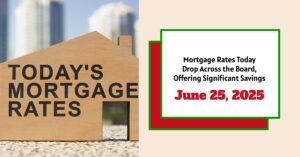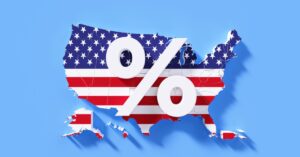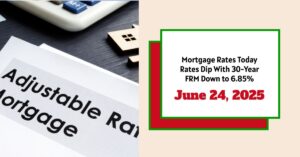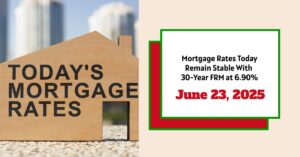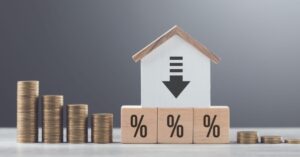As of June 25, 2025, mortgage rates have seen a slight decrease, providing potential homeowners and those looking to refinance a bit of financial reprieve. The national average for a 30-year fixed mortgage rate stands at 6.81%, a dip from 6.83% the day before. This drop reflects a larger picture where rates were at 6.91% just a week earlier. For many, this drop in rates could mean significant savings in monthly payments and overall interest expenses.
Mortgage Rates Today – June 25, 2025: Rates Drop Across the Board
Key Takeaways:
- The national average rate for a 30-year fixed mortgage is 6.81%, down from 6.91% last week.
- 15-year fixed mortgage rates are stable at 5.87%.
- The 5-year ARM rate has increased to 7.39%.
- National refinance rates for the 30-year fixed loan are currently approximately 7.10%.
- Predictions suggest that mortgage rates may hover around the mid-6% range for the remainder of 2025.
Current Mortgage Rates Overview
Understanding today’s mortgage rates involves exploring various loan types available in the market. Here’s how the current mortgage rates stack up as of June 25, 2025:
| Loan Type | Current Rate | 1 Week Change | APR | 1 Week Change |
|---|---|---|---|---|
| 30-Year Fixed Rate | 6.81% | -0.02% | 7.35% | -0.02% |
| 20-Year Fixed Rate | 6.51% | -0.07% | 7.01% | +0.06% |
| 15-Year Fixed Rate | 5.87% | -0.09% | 6.24% | -0.03% |
| 10-Year Fixed Rate | 5.85% | -0.08% | 6.04% | -0.03% |
| 7-Year ARM | 7.44% | 0.00% | 8.02% | +0.20% |
| 5-Year ARM | 7.39% | +0.19% | 7.99% | +0.19% |
(Source: Zillow, June 25, 2025)
Current Refinance Rates
If you’re considering refinancing your home loan, the current offer provides an array of rates you might find accommodating. National refinance rates have remained relatively stable, making it a good time for many homeowners. Here is a breakdown of the current refinance rates:
| Loan Type | Current Rate | 1 Week Change | APR | 1 Week Change |
|---|---|---|---|---|
| 30-Year Fixed Rate | 7.10% | -0.06% | 7.33% | -0.04% |
| 15-Year Fixed Rate | 6.01% | +0.08% | 6.22% | -0.04% |
| 5-Year ARM | 8.04% | +0.11% | 8.25% | +0.15% |
Monthly Mortgage Payments Based on Current Rates
When it comes to buying a home, understanding how mortgage rates translate into your budget is essential. Here, we present estimates for monthly payments based on the current rate of 6.81% for a 30-year fixed mortgage.
Monthly Payment on a $300,000 Mortgage
For a typical $300,000 mortgage, the estimated monthly payment (excluding taxes and insurance) at 6.81% is approximately $1,946. In the early years of a mortgage, most of the payment goes toward interest, meaning a significant portion of your expenses is primarily interest.
Monthly Payment on a $400,000 Mortgage
Now, moving to a $400,000 mortgage, at the same interest rate, results in an estimated monthly payment of about $2,595. This amount underlines the financial responsibility of homeownership and emphasizes the necessity for a well-planned budget.
Monthly Payment on a $500,000 Mortgage
For those considering a larger purchase, the monthly payment for a $500,000 mortgage would be approximately $3,243. Larger loans mean larger financial commitments, stressing the importance of understanding one’s budget and potential costs.
| Mortgage Amount | Estimated Monthly Payment |
|---|---|
| $300,000 | $1,946 |
| $400,000 | $2,595 |
| $500,000 | $3,243 |
Understanding the Impacts of Interest Rates on Homeownership
The fluctuations in mortgage rates can significantly impact prospective buyers. As home prices have risen over the past few years in many markets, the cost of borrowing needs to be considered in conjunction with property prices. An increase in interest rates can mean a drastically altered monthly payment. If rates rise while home prices remain steady or increase, many potential buyers may find themselves priced out of the market.
Impact of Interest Rate Changes:
- Affordability: Increased rates mean higher monthly payments, which can squeeze budgets, making homes less affordable.
- Buying Power: A drop in rates could improve buying power, allowing individuals to consider homes that were previously beyond their financial reach.
Additionally, individuals should be aware of how these changes affect their ability to refinance. Lower rates can also encourage current homeowners to lock in better terms than before, solidifying their financial health.
Related Topics:
Mortgage Rates Trends as of June 24, 2025
Are Mortgage Rates Expected to Go Down?
The future of mortgage rates is uncertain, but several analysts predict that rates may stabilize or see a modest decrease. According to the National Association of REALTORS® (NAR), home sales are expected to rise significantly in 2025, which could create a more favorable environment for buyers. Lawrence Yun, the chief economist of NAR, has indicated that the second half of 2025 might average mortgage rates around 6.4%, which would further boost affordability.
In contrast, the Mortgage Bankers Association suggests rates could remain steady in the mid-6% range as inflation continues to be a concern, potentially pushing rates back up towards the end of the year. The interplay of economic factors means that predictions vary widely. These fluctuations showcase the complexities of the current mortgage landscape.
Current Economic Indicators Affecting Mortgage Rates
Economic indicators also play a crucial role in shaping mortgage rates. When the U.S. economy heads into a downturn or uncertainty arises, rates can fall, stimulating buying activity. Some key economic indicators to remain aware of are:
- Inflation Rates: High inflation can lead to increased interest rates as lenders aim to maintain their profit margins.
- Employment Rates: Strong employment numbers can boost consumer confidence, potentially driving home sales up and affecting rates positively.
- The Federal Reserve’s Actions: Decisions made by the Federal Reserve regarding interest rates set the tone for all other rates in the economy, including mortgages.
Final Thoughts on Current Mortgage Rates
Staying informed about today’s mortgage rates is vital for those looking to purchase a home or refinance. The slight decrease can open more doors for potential buyers. It’s essential to grasp how these rates influence monthly payments and the overall affordability of homeownership. Each decision in this arena should be made with careful consideration of current economic conditions, individual financial circumstances, and forecasts about future rates.
Invest Smarter in a High-Rate Environment
With mortgage rates remaining elevated this year, it's more important than ever to focus on cash-flowing investment properties in strong rental markets.
Norada helps investors like you identify turnkey real estate deals that deliver predictable returns—even when borrowing costs are high.
HOT NEW LISTINGS JUST ADDED!
Connect with a Norada investment counselor today (No Obligation):
(800) 611-3060
Also Read:
- Will Mortgage Rates Go Down in 2025: Morgan Stanley's Forecast
- Expect High Mortgage Rates Until 2026: Fannie Mae's 2-Year Forecast
- Mortgage Rate Predictions 2025 from 4 Leading Housing Experts
- Mortgage Rates Forecast for the Next 3 Years: 2025 to 2027
- 30-Year Mortgage Rate Forecast for the Next 5 Years
- 15-Year Mortgage Rate Forecast for the Next 5 Years
- Why Are Mortgage Rates Going Up in 2025: Will Rates Drop?
- Why Are Mortgage Rates So High and Predictions for 2025
- Will Mortgage Rates Ever Be 3% Again in the Future?
- Mortgage Rates Predictions for Next 2 Years
- Mortgage Rate Predictions for Next 5 Years
- Mortgage Rate Predictions: Why 2% and 3% Rates are Out of Reach
- How Lower Mortgage Rates Can Save You Thousands?
- How to Get a Low Mortgage Interest Rate?
- Will Mortgage Rates Ever Be 4% Again?
